

1. Shakespeare Garden, Central Park
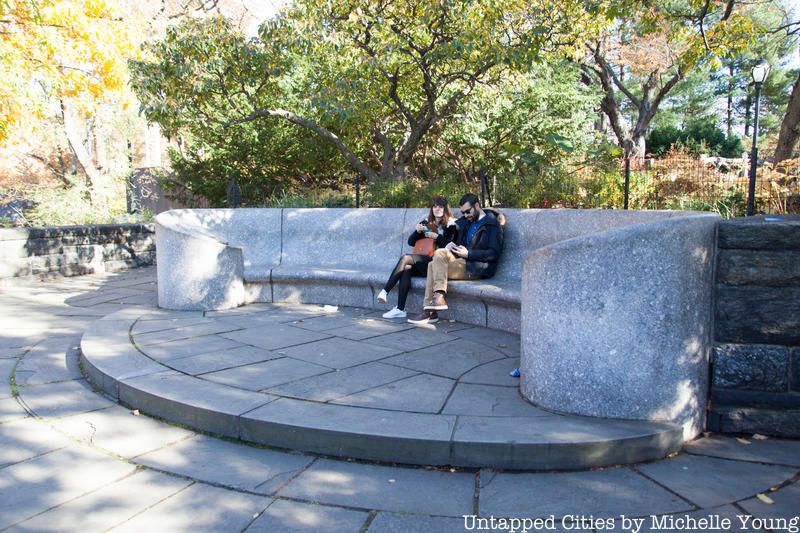

The Shakespeare Garden is a four acre landscaped garden in Central Park, located near 79th Street on the west side of the park. In 1913, it was officially dedicated to Shakespeare and possesses flowers and plants mentioned in his works. With its informal layout and winding paths, it was said to be a “woman’s garden” but is of course enjoyed by all today.
The flora is accompanied by bronze plaques with quotations from Shakespeare’s texts. On May 12, 1917, an oak tree grafted from one planted by Shakespeare was placed in the garden on the commemoration of Shakespeare’s tricentenary, though it is no longer there. There’s also another Shakespeare Garden in the Brooklyn Botanic Garden.
2. Shakespeare Statue, Central Park
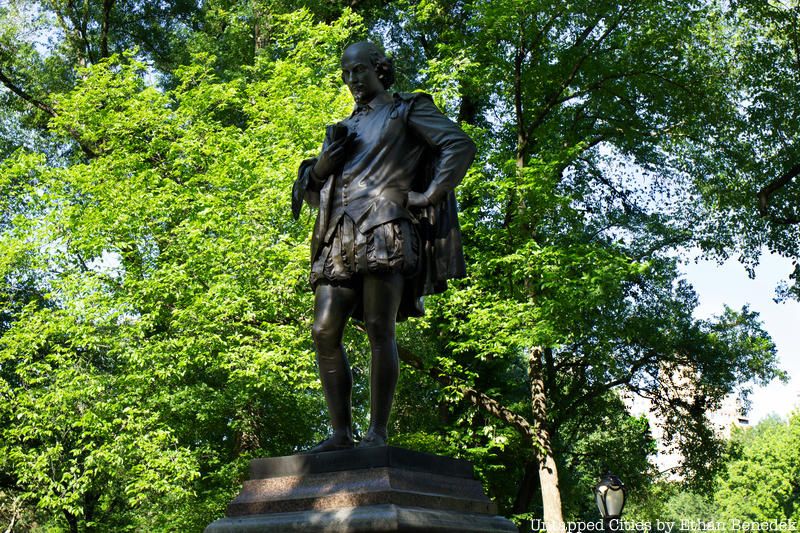
In 1864, a cornerstone was laid for a statue of Shakespeare in Central Park. It was done at the behest of a group of actors and theatre managers to commemorate the Bard’s tricentenary. A benefit performance of Julius Caesar was held on November 25, 1864, which over 2,000 people attended, to help subsidize the statue Central Park statue. What made this performance notable, in hindsight, was that it starred Junius Brutus Booth Jr., Edwin Booth (who founded the Player’s Club), and John Wilkes Booth, who would assassinate President Abraham Lincoln less than five months later.
It took until 1866 for a design competition to be held and for John Quincy Adams Ward to be selected as the sculptor and Jacob Wrey Mould designed the pedestal. The Literary Walk statue of Shakespeare was dedicated in 1872.
3. Delacorte Theatre Sculptures, Central Park
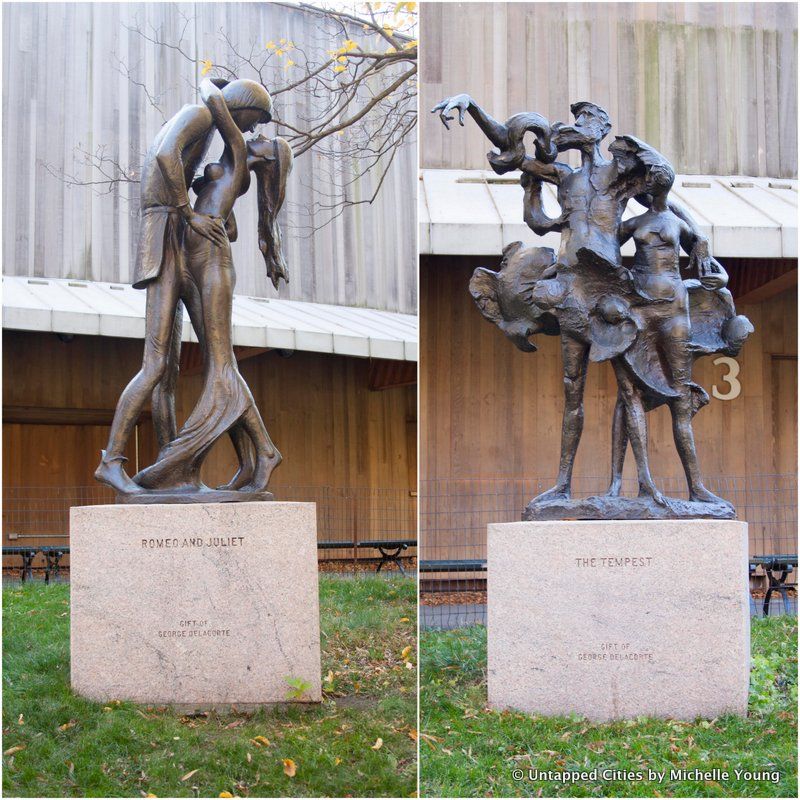
The Delacorte Theatre is home to Joseph Papp’s Shakespeare in the Park. Just outside of the Delacorte are two sculptures that memorialize Shakespeare’s connection to the theater. The bronze statues were designed by Milton Hebald and dedicated in the 1970s. The sculptures along with the theater were gifts of philanthropist George T. Delacorte. One depicts Romeo and Juliet and the other Prospero and Miranda, from The Tempest.
4. Puck Sculpture, Puck Building
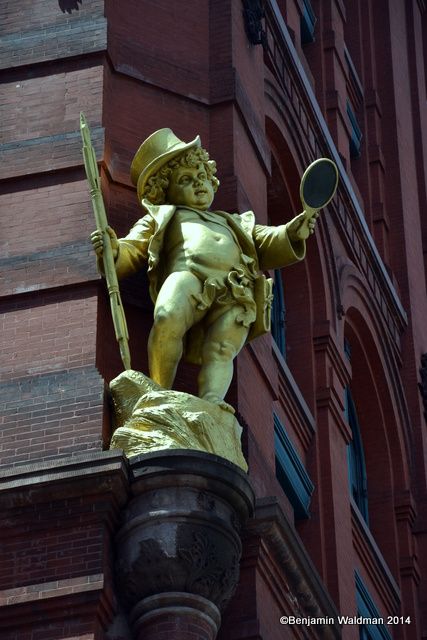
In 1876, Joseph Keppler and Adolph Schwarzmann founded Puck, a satirical magazine that published, according to Daytonian in Manhattan, “Political corruption, the latest fashion trends, labor unions, suffragists and all forms of graft, extravagance and unjustice” The magazine constructed its Romanesque Revival headquarters on Lafayette Street in 1885. The building is notable for its two gilded statues of Puck, from A Midsummer’s Night Dream, designed by Henry Baerer.
5. Yorick’s Skull and Shakespeare Bust, The Players Club

The Players Club was founded in 1888 by Edwin Booth, the prominent Shakespearean actor and brother of John Wilkes Booth, along with 15 other incorporators (including Mark Twain and General William Tecumseh Sherman). Booth purchased an 1847 mansion fronting Gramercy Park and hired Stanford White to redesign it. During his lifetime, Booth lived in the mansion’s upper floors and his room remains as it was when he died (including a skull he used in Hamlet). In the above photograph, Yorick’s skull is in the back corner atop the bookshelf and Shakespeare’s bust is on the right on a ledge. For more photographs of the Players Club check out our previous coverage.
6. Shakespeare Rondel, The Caroline Apartments
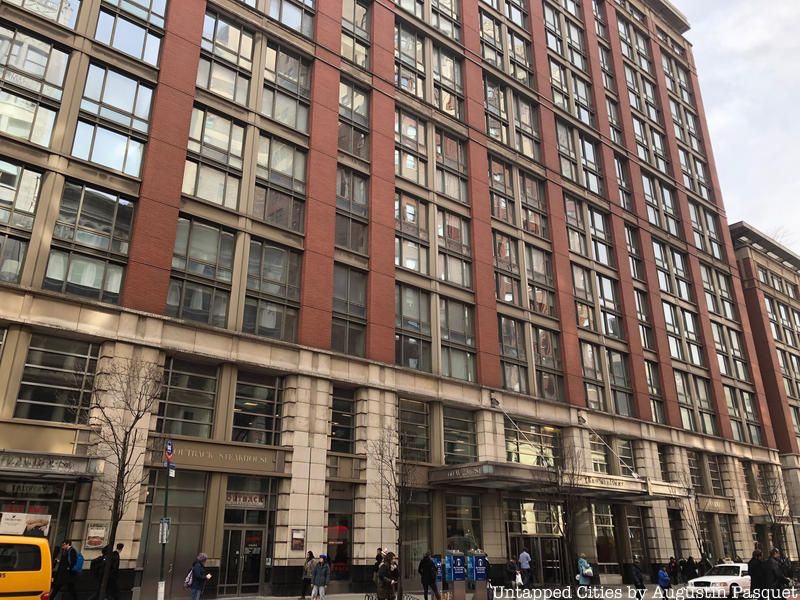
The Caroline is a modern, twenty-first century, building located on 23rd Street and Sixth Avenue. It is located on the site of the Booth’s Theatre, a Second Empire style building built by Edwin Booth and opened in 1869. It was never financially successful and was converted into a department store in 1881. The building was demolished in 1965 (or 1975) to make room for a parking lot. The theater had some of the latest technology including hydraulic lifts and lights that could be completely extinguished. It possessed a statue of Booth’s father and a statue of Shakespeare above the proscenium arch. When the building was demolished, Gerard Wolfe, a former NYU professor saved the bust of Shakespeare. It was displayed at NYU until The Caroline was erected and the bust returned to its 23rd Street home.
7. The Merchant of Venice Tympanum, Jefferson Market Library
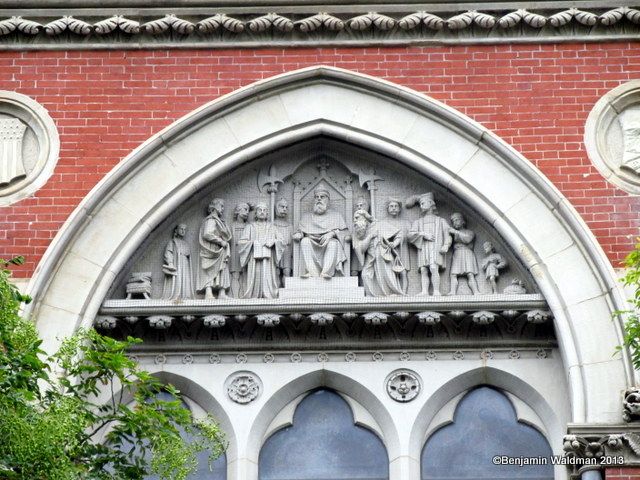
The Jefferson Market Library was constructed between 1874-1877 as the Third Judicial District Courthouse with an adjoining jail. Its name was derived from the market originally located on the site which was named after Thomas Jefferson in the early 1830s.The tympanum, above the Library’s portal contains a scene from The Merchant of Venice. In a space that would normally depict Jesus in a church, the architect depicted the courtroom scene where Shylock is demanding his pound of flesh. The judge is seated in the center, to his right is Shylock with a pair of scales in one hand and a dagger in the other, and on the left is Portia pointing to the contract.
Check out our previous coverage of the Jefferson Market Library in 15 Former Prisons in NYC and the Library’s Stained Glass Reading Room
8. Shakespeare Avenue and School, The Bronx
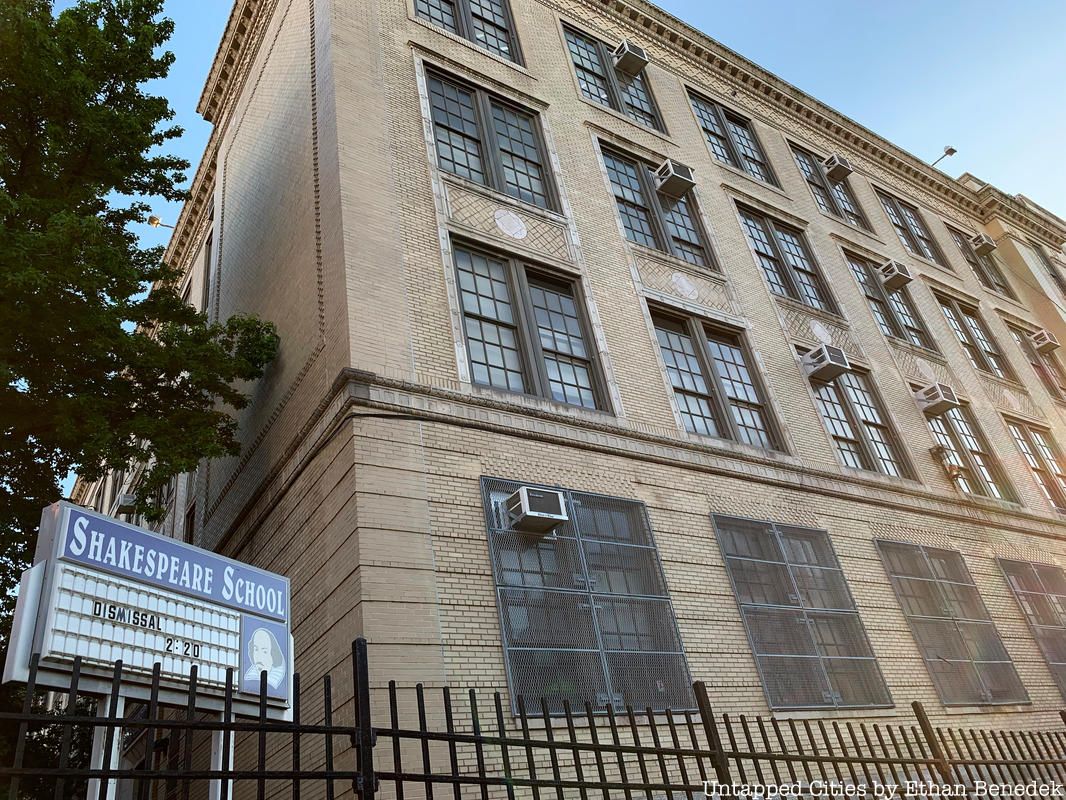
According to McNamara’s Old Bronx, Shakespeare Avenue was named after the Shakespearean Garden that could be found on the former Marcher estate. According to John McNamara, The Shakespeare Garden “was a formal garden containing many of the flowers mentioned in Shakespeare’s plays, and embellished by marble busts of the Bard himself, and some of his creations, such as Puck, Romeo and Juliet, Hamlet, Shylock and Portia. Other statues were placed in arbors and along the footpaths. Rebecca Marcher, averred the old watchman, pursued the theme by naming her horses and dogs Macbeth, Pyramus and Thisbe, and Falstaff.”
It is unknown what happened to these statues. Eventually the estate was subdivided and Marcher Avenue was created. In 1901, the Board of Public Improvements resolved to rename Marcher Avenue, Shakespeare Avenue, which was then ordained by the Municipal Assembly. Today, there is also a Shakespeare School located there.
9. Ophelia at the Former I. Miller Shoe Store in Times Square
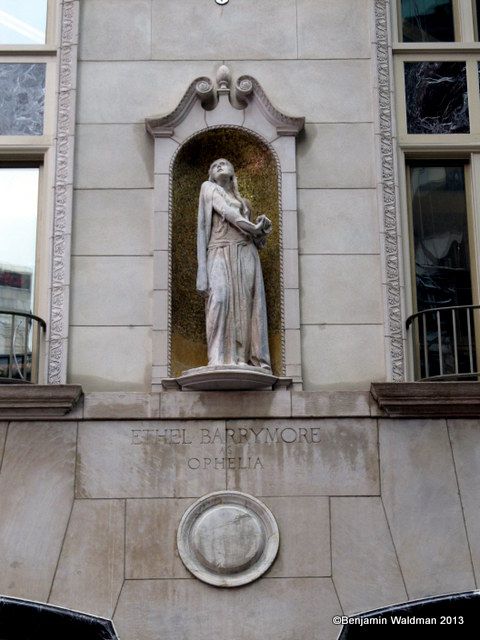
In 1926, Israel Miller hired Louis Friedland to renovate the buildings at the corner of 46th Street and Broadway for his shoe store. Miller was a Polish immigrant, who specialized in bespoke shoes for dancers and actors. The I. Miller Shoe Store remained in operation through the 1970s. Miller erected four statues representing women in the arts, his clientele, that were only rediscovered by the public in early 2014 when billboards were removed.
Drama is represented by Ethel Barrymore as Ophelia, from Hamlet; Musical Comedy is represented by Marilyn Miller as Sunny; Opera is represented by Rosa Ponselle as Leonora; and Motion Pictures are represented by Mary Pickford as Little Lord Fauntleroy.
10. Shakespeare Busts at National Arts Club
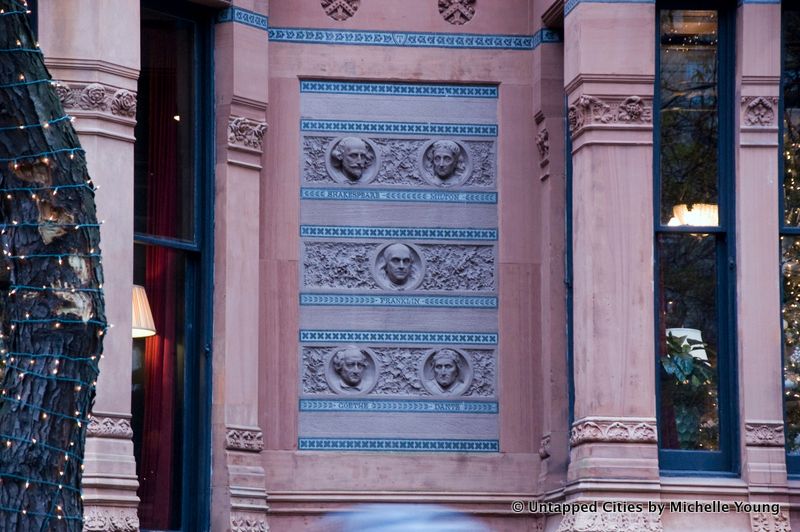
Facade of the Brooklyn Historical Society
Busts of Shakespeare can be found on a number of buildings throughout New York City. That demonstrate the high standing and cultural status that Shakespeare had in late nineteenth-century New York City. One can be found in Samuel Tilden’s Gramercy Park Mansion (now the National Arts Club). It appears alongside busts of Dante, Franklin, Milton, and Goethe and were designed by Calvert Vaux for Tilden.
11. Shakespeare Bust at the Abandoned Public School 31 in the Bronx
Public School 31 in the Bronx, once known as the “Castle on the Concourse,” was designed by C. B. J. Snyder in 1899. The landmarked building has been abandoned by the City and been left to rot. One of the few architectural remnants still visible is a bust of Williams Shakespeare, but the building was slated for demolition as of 2015.
12. Brooklyn Historical Society
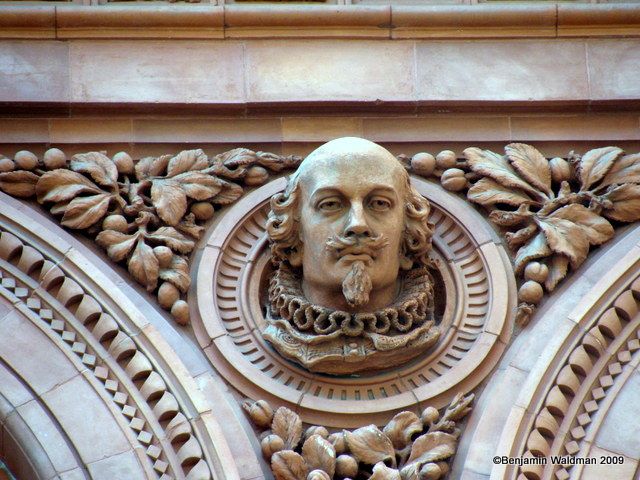
Lastly, Shakespeare can be found on the facade of George B. Post’s Renaissance Revival Brooklyn Historical Society building in Brooklyn Heights. Busts of Shakespeare, along with Michelangelo, Beethoven, Gutenberg, Columbus, and Franklin were designed by Olin Levi Warner.
Another Shakespeare bust can be found on the former Bronx home of Edwin Shuttleworth and his wife. The house was designed by Neville and Bagge and contains busts of Shakespeare and Dante on its facade.
Next, See the Top 10 Secrets of Central Park and Where Children’s Stories Come Alive in NYC.

